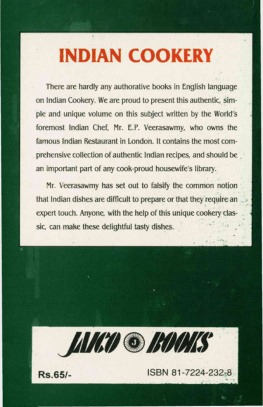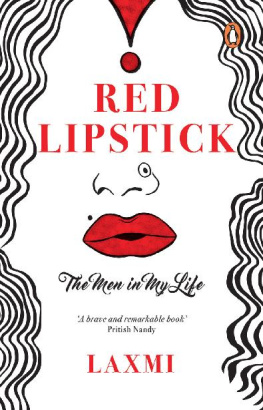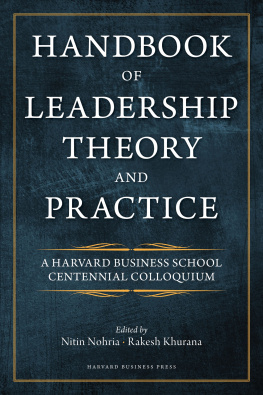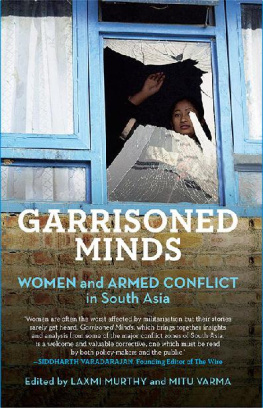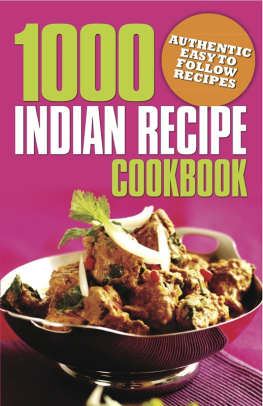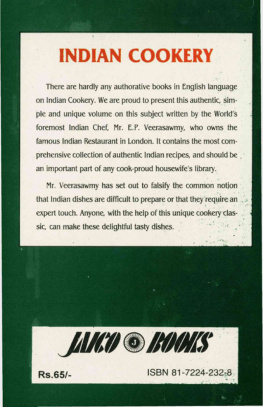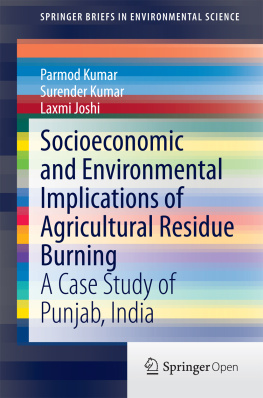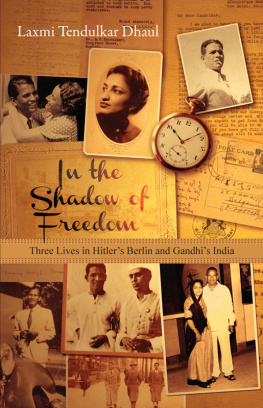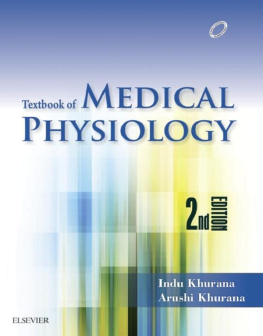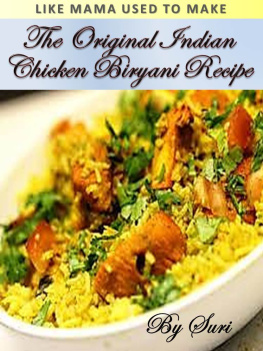Laxmi Khurana - An Indian housewifes recipe book
Here you can read online Laxmi Khurana - An Indian housewifes recipe book full text of the book (entire story) in english for free. Download pdf and epub, get meaning, cover and reviews about this ebook. year: 2000, publisher: Elliot Right Way Books, genre: Home and family. Description of the work, (preface) as well as reviews are available. Best literature library LitArk.com created for fans of good reading and offers a wide selection of genres:
Romance novel
Science fiction
Adventure
Detective
Science
History
Home and family
Prose
Art
Politics
Computer
Non-fiction
Religion
Business
Children
Humor
Choose a favorite category and find really read worthwhile books. Enjoy immersion in the world of imagination, feel the emotions of the characters or learn something new for yourself, make an fascinating discovery.
- Book:An Indian housewifes recipe book
- Author:
- Publisher:Elliot Right Way Books
- Genre:
- Year:2000
- Rating:3 / 5
- Favourites:Add to favourites
- Your mark:
- 60
- 1
- 2
- 3
- 4
- 5
An Indian housewifes recipe book: summary, description and annotation
We offer to read an annotation, description, summary or preface (depends on what the author of the book "An Indian housewifes recipe book" wrote himself). If you haven't found the necessary information about the book — write in the comments, we will try to find it.
An Indian housewifes recipe book — read online for free the complete book (whole text) full work
Below is the text of the book, divided by pages. System saving the place of the last page read, allows you to conveniently read the book "An Indian housewifes recipe book" online for free, without having to search again every time where you left off. Put a bookmark, and you can go to the page where you finished reading at any time.
Font size:
Interval:
Bookmark:
HOUSEWIFES
RECIPE BOOK
In the same series
The Curry Secret
The New Curry Secret
Steaming!
Ice Cream Made Easy
Chinese Cookery Secrets

Constable & Robinson Ltd
3 The Lanchesters
162 Fulham Palace Road
London W6 9ER
www.constablerobinson.com
First published in the UK, 1985
This edition published by Right Way,
an imprint of Constable & Robinson, 2009
Copyright Laxmi Khurana, 1985, 2009
The right of Laxmi Khurana to be identified as the author of this work has been asserted by her in accordance with the Copyright, Designs & Patents Act, 1988.
All rights reserved. This book is sold subject to the condition that it shall not, by way of trade or otherwise, be lent, re-sold, hired out or otherwise circulated in any form of binding or cover other than that in which it is published and without a similar condition including this condition being imposed on the subsequent purchaser.
A copy of the British Library Cataloguing in Publication Data is available from the British Library
ISBN: 978-0-7160-2078-3
Printed and bound in the EU
The author is an Indian housewife, living in Britain. She enjoys cooking and has made it one of her particular hobbies and interests. When entertaining friends she has often heard remarks to the effect that Indian cooking is complicated, time-consuming and very difficult. This is not true. Indian cooking can be fun and simple. This book removes the myths, and explains Indian cooking by straightforward step by step methods. Many of the recipes in the book are for family dishes which would not be served in restaurants. Hence the title An Indian Housewifes Recipe Book.
Writing a book while in full time employment is not easy. My family and especially my children have shown a lot of patience and given me every encouragement. My children and many of my friends have been guinea pigs for testing the recipes. I would therefore like to thank all my friends for their efforts, and the question Why dont you write a book? This is basically what started it.
So I would like to dedicate the book to my two children Micky and Reeta and my husband, without whose efforts this book would have never seen completion.
Indian food, and spicy food in general, has become common and increasingly popular outside India over the past few decades. This is especially true in the UK, where cosmopolitan influences have increased the number of non-English restaurants considerably. In spite of all this, there remains a myth that Indian cooking is cumbersome and time-consuming. This book explains how Indian cooking can be simple, based on a few, well-known spices which are easily available.
For simplicity I have divided Indian cooking into a number of sections: starters; savoury snacks; meat and fish curries; dhals; vegetable curries; chutneys, pickles and raitas; sundries, like chapattis, rice, etc; and sweets. Starters and meat curry dishes are pretty standard, and easily understood by most people. However, the dhals and vegetable curries offer a lot of variety and are much used in Indian homes, but are not so readily available in restaurants. Therefore, besides covering the more popular meat and sundry cookery, this book covers a range of dhal and vegetable dishes to give you the opportunity of trying them.
Utensils and Equipment
Here are some basic utensils and equipment needed for Indian cooking:
a tava heavy-based flat pan which can be bought at most Indian shops. If this is not available, then a large heavy-based frying pan can be used;
a liquidizer or food processor;
a sieve or skimmer (used for deep frying foods);
a wok, or a large, deep frying pan;
a colander; and
a large serving spoon (marked with spoon measurements ).
In India, and in many restaurants in the UK, a tandoor is often used. The tandoor is a clay oven, which is heated to a very high temperature in excess of 800F (430C). Most Indian homes in the UK do not have a tandoor, and therefore normally use an ordinary oven for tandoori dishes.
Ingredients
Some of the commonly used ingredients include: tandoori masala, garam masala, madras curry powder, garlic, ginger (both fresh and powdered), chilli powder, turmeric powder, hing (asafoetida), coriander (fresh, seeds and powdered), black peppercorns, cinnamon, cardamom, cloves, nutmeg, cumin (both seeds and powdered), fennel seeds, fenugreek seeds, rai (both black mustard seeds and powder), soy sauce and ghee.
Tandoori masala, garam masala and madras curry powder are mixtures of other spices.
Tandoori masala is a combination of salt, coriander, cardamom powder, cinnamon powder, black peppercorns, cumin powder, ground cloves, chilli powder, ground bay leaves, mace, nutmeg, fenugreek powder, garlic powder and ginger powder. It is easily available in most large supermarkets.
Garam masala is a combination of coriander powder, cumin powder, black peppercorns, ginger powder, cinnamon powder, pimento, cardamom powder, ground bay leaves, ground cloves and nutmeg. This again is easily available in large supermarkets.
Madras curry powder, again very easily available from most supermarkets, is a mixture of cumin powder, chillies, turmeric powder, ground mustard seeds, ground poppy seeds, garlic powder, and ground fenugreek.
Ginger is available in both fresh and powder form, and is a reddish-brown coloured root. To use fresh ginger, remove the skin of the root and then chop finely. In powdered form, the root is first dried and then ground. Ginger can be purchased already powdered.
Garlic, again, is available in both fresh and powdered form. It is a very strong-smelling bulb, consisting of a number of small sections, known as cloves of garlic. To use fresh garlic, remove the skin from the clove, and chop finely. For the powdered form, the garlic is dried and then ground, or it can be purchased already powdered.
Chilli powder is often available in varying degrees of hotness. I recommend that milder forms of chilli powder are used initially. After some time, when you really want to try extra hot dishes, then either use slightly larger quantities of mild chilli powder, or buy a hotter variety.
Fresh green chillies are used in many recipes. If these are chopped by hand (rather than a liquidizer or food processor), you should make sure that you wash your hands with soap immediately after cutting them. This is essential because otherwise a burning sensation will be felt on your hands. This sensation transfers to any other part of your body that you touch. Fresh green chillies are available at most supermarkets.
Turmeric powder is the powdered form of the stem of a plant. It is bright yellow in colour and is widely available.
Hing (asafoetida) is a gum resin which is available either in gum or powder form. It has a very strong smell, and is mainly used for flavouring. It also aids digestion. It is available in most Indian shops but is not generally found in supermarkets. Some of the curries in this book use hing, but if it is not available, then the curry can be cooked without it. The fragrance of the curry will be less strong but only a small difference in taste is apparent.
Coriander is available in three forms: fresh, which is a green leaf used for garnishing and flavouring; powder, which is used for flavouring; and seeds, which are sometimes used for growing fresh coriander. Powdered coriander is easily available, but fresh coriander can be difficult to obtain. If it is not available then use fresh parsley for garnishing instead.
Font size:
Interval:
Bookmark:
Similar books «An Indian housewifes recipe book»
Look at similar books to An Indian housewifes recipe book. We have selected literature similar in name and meaning in the hope of providing readers with more options to find new, interesting, not yet read works.
Discussion, reviews of the book An Indian housewifes recipe book and just readers' own opinions. Leave your comments, write what you think about the work, its meaning or the main characters. Specify what exactly you liked and what you didn't like, and why you think so.


